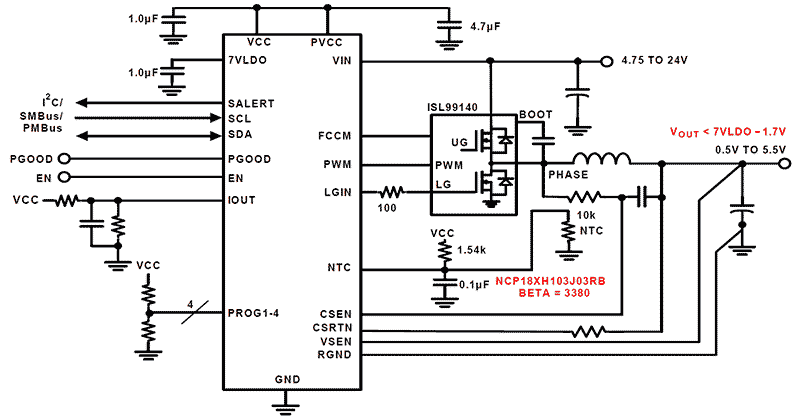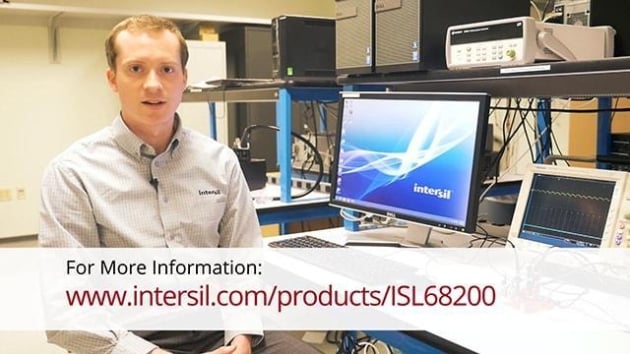特長
- ルネサス独自のR4テクノロジー
- 最適な過渡応答を実現するリニア制御ループ
- 負荷過渡時に周波数とデューティサイクルを可変制御し、可能な限り高速な応答を実現
- ワイドレンジ入力用の電圧フィードフォワードを内蔵
- 入力電圧範囲 4.5V~24V
- 出力電圧範囲 0.5V~5.5V
- リモートセンスによる±0.5% DAC精度
- すべてのセラミック・ソリューションをサポート
- 単一入力レールソリューション用の統合LDO
- SMBus/PMBus/I2C互換、最大1.25MHz
- コンフィギュレーション・ピンによる256の起動電圧レベル
- 300kHz~1.5MHzの8種類のスイッチング周波数オプション
- PFM動作オプション、ISL99140と互換性があり、軽負荷効率を改善
- プリチャージ負荷への起動
- 高精度イネーブル入力により、高入力UVLOとパワー・シーケンス、フォルト・リセットを設定可能
- ソフトスタートと故障検出のためのパワー・グッド・モニター
- 高いシステム信頼性のための包括的な故障保護
- 過熱保護
- 出力過電流および短絡保護
- 出力過電圧および低電圧保護
- オープン・リモート・センス保護
- 5Vまたは3.3V PWM入力DrMOSまたはスマート・パワー・ステージ(SPS)対応
- ルネサスのPowerNavigatorソフトウェアに対応
説明
ISL68201は、ルネサス独自のR4™テクノロジーを採用した単相同期降圧PWMコントローラで、入力電圧4.5V~24V、出力電圧0.5V~5.5Vと広い範囲をサポートします。内蔵LDOがコントローラのバイアス電圧を供給するため、単一電源動作が可能です。ISL68201は、デバイスのコンフィギュレーション、テレメトリ(VIN、VOUT、IOUT、温度)、およびフォールト・レポート用のPMBus/SMBus/I2Cインターフェイスを備えています。インターシル独自のR4制御方式は、極めて高速な過渡性能、正確に調整された周波数制御、およびすべての内部補償を備えています。効率を高めるPFMモードを有効にすることで、軽負荷時の効率を大幅に改善できます。ISL68201のシリアル・バスはR4ループの最適化を容易にし、すべてのセラミック出力フィルタを含む幅広いアプリケーションで高速な過渡特性を実現します。ISL68201には4つの8ビット・コンフィギュレーション・ピンがあり、NVMメモリを内蔵することなく、非常に柔軟なコンフィギュレーション・オプション(周波数、VOUT、R4ゲインなど)を提供します。この結果、従来のアナログ・コントローラに近い設計フローを実現しながら、デジタルPMBus/SMBus/I2Cインターフェイスの設計柔軟性と機能セットを提供します。また、ISL68201はリモート電圧センシング機能を備え、リモートグランドとローカルグランド間の電位差を完全に排除します。これにより、レギュレーションと保護の精度が向上します。高精度イネーブル入力は、ISL68201の起動を他の電圧レールと調整するために使用でき、特に電源シーケンスに便利です。
パラメータ
| 属性 | 値 |
|---|---|
| Output Current (Max) [Rail 1] (A) | 40 |
| Switching Frequency Range (Typical) (kHz) | 300 - 1500 |
| Qualification Level | Standard |
| Temp. Range (°C) | -40 to +85°C |
| Simulation Model Available | iSim |
パッケージオプション
| Pkg. Type | Pkg. Dimensions (mm) | Lead Count (#) | Pitch (mm) |
|---|---|---|---|
| QFN | 4.0 x 4.0 x 0.90 | 24 | 0.5 |
適用されたフィルター
フィルター
ソフトウェア/ツール
サンプルコード
シミュレーションモデル
These PMBus™ compatible single-phase digital hybrid DC/DC controllers are ideal for point-of-load (POL) conversions. They support a wide range of applications, including FPGAs, DSPs, ASICs, processors, and general-purpose system rails.
The ISL68200 model is integrated with MOSFET drivers, making power supply design simpler. The ISL68201 features a PWM output for efficient performance. Both models are designed to meet the demands of data centers and wireless infrastructure applications.



